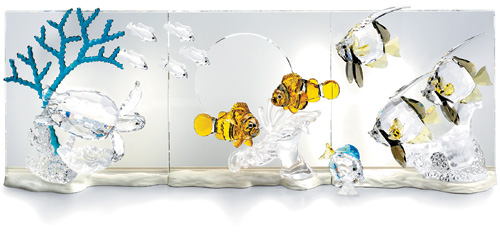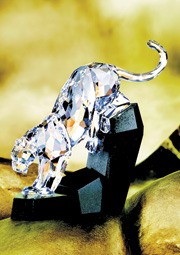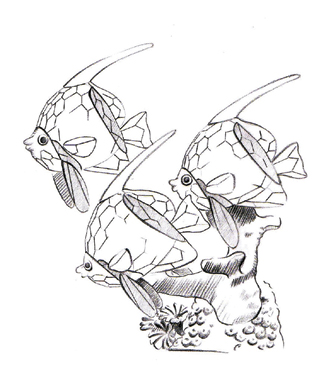A glittering menagerie where the lights stay on

before realizing the design in crystal. Provided by Swarovski Korea.a panther, a school of banner fish and a walrus.He incorporates natural stone, such as granite and marble, to use as a stand for the animals, as shown here
For Heinz Tabertshofer, a 45-year-old designer at Swarovski, his crystal collection is based on the the fascinating world of nature that he loves so much. On a shelf in front of him a flying eagle lands for a second on a rock, a ferocious panther prowls a plain, a grizzly bear howls aloud. In reality, nothing moves, but it doesn’t seem that way. His best pieces have a fluidity that seems to deny the fact that these are inanimate objects.

he designer Heinz Tabertshofer’s latest crystal sculptures include
“I love nature and my inspiration comes from nature,” said Mr. Tabertshofer, sipping hot tea in the Lotte Hotel lounge. “I go out and watch animals in the Alps. I also watch movies about animals and spend a lot of time at the zoo.” He giggled as he said he even enjoys watching Walt Disney films and worked on Walt Disney figures four years ago.
During his tour of Korea he will visit Seoul, Daegu and Busan. Previously he was in Japan. Next he will fly to Europe, then the United States, India and Dubai.
Today, the name Swarovski is synonymous with the world’s finest crystal products. The company was founded in 1892 by Daniel Swarovski (1862-1956), who invented a machine that made it possible to cut crystal to a higher level of precision than was possible with traditional manual methods. He then founded the company, in Wattens, and his vision has been continued through the years. Swarovski crystal is now made in 16 countries including Argentina, Brazil, China, Italy, Lithuania and the United States.

He starts with a conceptual sketch,
The company’s first collaboration with a fashion house came in 1956. In association with Christian Dior, Swarovski developed the aurora borealis technique, a shimmering finish that enhanced the sparkle of cut crystal. Crystal Mesh, Swarovski’s 1993 invention, is used extensively by leading fashion brands such as Dolce & Gabbana and Chanel. The Swarovski company now has over 560 boutiques worldwide and its sales in 2005 exceeded $2 billion.
For Mr. Tabertshofer, a native of Tyrol, his path to Swarovski began when he was 17 and he became interested in the arts and crafts. While attending a technical college in Jenbach, he worked as an apprentice to a locksmith, who made tools for machinery. His master one day proposed the young artist make molds for crystal pieces. “It was a lot of hand work and a challenge for me but I loved it,” he said. “And I got to experiment with various materials including iron, zinc, copper, bronze and lead.”
He proceeded to make molds for various animals and as well as for jewelry and chandeliers. Ten years ago, Mr. Tabertshofer joined Swarovski when it was looking for a designer with a technical background.
When asked about the changes over the years in the production of crystal sculptures, he said, “Time pressure is the biggest challenge. It takes two years to develop a product and the company needs to release many new designs every year.”
He added that quality has greatly improved. Over the past 15 to 20 years, he saw major changes, especially in cutting and modeling. Designers study the anatomy of animals and take art courses outside the company so intricate shapes have become possible.

Heinz Tabertshofer, Swarovski’s designer of the year, with his imaginary animals. By Ines Cho
In traditional crystal production, lead was used but that’s now forbidden. “Lead is softer to work with and creates a more sparkling product but because it was banned the company changed the ingredients of its crystal.”
So what goes into crystal? “I don’t know exactly. That’s a secret!” he replied laughing.
Pointing at a large Swarovksi tropical bird, he said ingredients like copper or gold might be added to create specific colors. The cockatoo looked as if its head had been kissed by a red sunset and its long tail dipped in a blue lagoon.
Swarovski’s ambition is to expand its luxury sales and some of its pieces now cost up to $4,000.
“The campaign to go high-end was only adopted last year on a global basis,” said Sun Hwang, the country manager of Swarovski Korea. “But Korea has always used this strategy. We have exclusive exhibitions for VIPs, for example.”
Capturing the essence of nature using crystal is a labor-intensive process. The designer said the main shapes are made first, using molds. They are then cut to form details and then all the pieces are glued together.
Upon close inspection, one can count the number of components in a Swaroksi piece. A panther, for example, is made from 16 components. If one piece breaks, that part can be replaced. Repairs are offered by Swarovski stores around the world.
That would have been useful for Laura in the Glass Menagerie ― her favorite glass unicorn gets broken toward the play’s end and soon after she plunges the stage into darkness signifying her despair.
If Mr. Tabertshofer had been around he could have made her a new unicorn that would have lit up her life with dazzling light.
By Ines cho Staff Writer [inescho@joongang.co.kr]










with the Korea JoongAng Daily
To write comments, please log in to one of the accounts.
Standards Board Policy (0/250자)